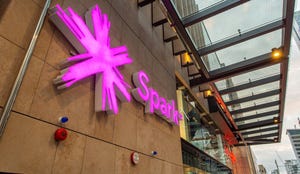Stan Lumish, JDS Uniphase
"We were a confederation of states before, and not necessarily a happy confederation, but we're integrated now."
February 27, 2004


Stan Lumish, CTO at JDS Uniphase Corp. (Nasdaq: JDSU; Toronto: JDU), learned optics as an intern at Bell Labs, the optical equivalent of taking batting practice with Alex Rodriguez. Lumish took notes from the industry legends who invented many of the fiber optic technologies we take for granted. He (Lumish, not A-Rod) stayed in the AT&T/Lucent world after that, moving to JDSU in 2000.
Taking a lunch break during OFC, Light Reading got a chance to chat with Lumish about JDSU's prospects.
Light Reading: What's going on in the M&A department, and with making the company into a cohesive whole?
Lumish: For the last fiscal year, which ended June 30, we went through a lot of fiscal cleaning up, a lot of pain. We were a confederation of states before, and not necessarily a happy confederation, but we're integrated now. Kevin [Kennedy, the CEO] is putting together a vision for the company. We needed that.
LR: What's your role as all these pieces come together?
Lumish: I'm on Kevin's staff, primarily in charge of communications [product lines], but I have responsibilities that cross into the non-telecom side. I came from the customer side of the house, so I have a pretty good view about what the customer requirements are. I've been in their chair.
I work with different business groups to look at technological challenges, more on a tactical basis than a strategic basis, looking at where I can help. I know a lot of people, and I've got a fair amount of currency around the industry.
LR: How have customer requirements changed since your days in the equipment business?
Lumish: When I was on that side, the idea of someone else making a circuit pack [a line card] was unthinkable. Even a transmitter -- it's gold, it's the secret sauce. Now it's not the secret sauce any more. And we have software people for the next layer of focus, making the optical layer more intelligent. Clearly we have to do it with our customers to make sure we get it right, but we think we add a lot there.
During the bubble, the major customers were responding to the startups. It was much more of an issue then. I was at Lucent, and Williams announced they had bought a system from Corvis. Oh, we were getting beat up by our marketing group. "How come we don't have a technology like that?" Of course, it turned out there was no market.
The customers are more conservative now. Nobody's gonna buy from a startup unless they [the startup] partner with a big guy -- a systems company or even a components company. The hard part is -- just as we face, our customers have a thinner bench. Often their experts have gone out to startups and dissipated. In that way, it's a challenge for them. We're ready to step up and bring our expertise.
LR: Any plans in monolithic integration or hybrid modules?Lumish: Oh, the IC kind of thing? The first OEIC [optoelectronic IC] that's out there, it doesn't have much "E" in it. It's an electroabsorption modulator with a laser in it. We watch the industry. The question is: Is there a cost benefit you get from it?
LR: How about tunability?
Lumish: We have a tunable dispersion compensator that is on the shelf, although if anyone asks, we can take it off the shelf. We were this close to productizing it. Customers were beating us up when we weren't making it. I said, "All right, we'll make it." Not a month later, they [the customers] cancelled their plans.
In tunable lasers we're announcing the TLM, the first fully tunable laser modulator [see JDS Barrages OFC]. The reconfigurable add-drop [a.k.a. ROADM] -- that's another exciting thing going on. I would say the kickoff is the DISA [project, the GIG-BE]. Part of the requirement is to have two-dimensional and, I think, n-dimensional all-optical reconfigurable add-drops. I think it's fair to say we're the only reasonable company left standing that can satisfy all that. We've done one before, a custom job -- an arrayed-waveguide-based, reconfigurable add-drop. What that did was exercise the expertise.
So this reconfigurability is happening now. We'll see it in the long-haul networks. The volumes won't be that big, but it's an important capability for our customers. We're gonna see it in the metro, too -- that's speculation on my part. It looks likely, though.
LR: Any interest in the all-optical switch?
Lumish: (Crosses knife and fork and raises them: Back, you monster!)
LR: Yeah, I kinda figured...
Lumish: There's a guy I work with that tells me all-optical crossconnects are the endgame. But how long out is that?
LR: Any Oscar picks?
Lumish: The Lord of the Rings has to win Best Picture.
LR: Just because?
Lumish: Not necessarily because it was such a great picture. There was just so much hype around it. I mean, it was good. I saw it with my son, and we had to sit in the front row -- maybe that's why I didn't enjoy it as much.
— Craig Matsumoto, Senior Editor, Light Reading
You May Also Like










